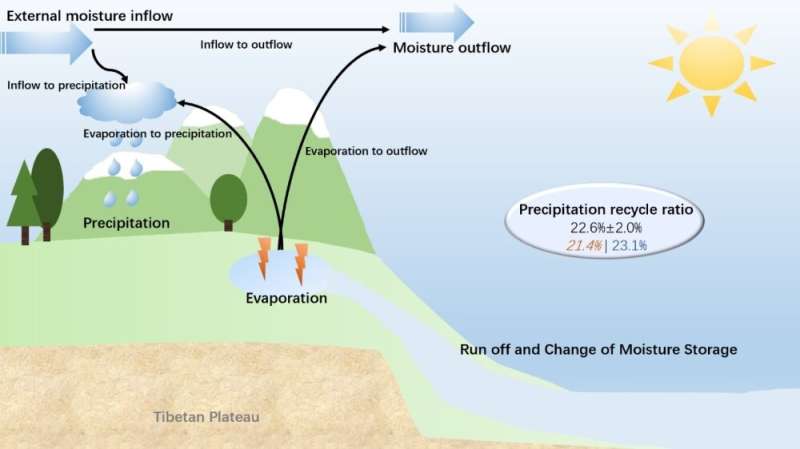El Niño impacts the precipitation recycle ratio over the Tibetan Plateau at interannual timescale

The water cycle over the Tibetan Plateau (TP), known as the "Asian Water Tower", is vital to the regional and downstream climate and ecosystem. A new study found that the interannual variability of the summer precipitation recycle ratio over the TP is influenced by the El NIño events in preceding winters. The study was published in Journal of Geophysical Research: Atmospheres and conducted by researchers from the Institute of Atmospheric Physics at the Chinese Academy of Sciences.
The precipitation recycle ratio is the contribution rate of the local evaporation to the total precipitation. "It's an important indicator of the water cycle process in the atmosphere. However, previous studies about precipitation recycle ratio over the TP remains inconclusive," said Dr. Tianjun Zhou, the corresponding author of the study. "The key point is the reasonable consideration of the atmospheric water vapor mixture processes."
Using the advanced reanalysis data ERA5 of the high resolution and a bulk model method, the team analyzed the interannual variability of the precipitation recycle ratio over the TP.
"The results show the impact of ENSO, the most significant variability of the climate system at interannual timescale," said Dr. Zhou. "In the El Niño decaying summers, the large-scale anomalous anticyclone spans over the Indo-Northwest Pacific and the westerly anomalies along the north flank of the anticyclone transport more moisture into the TP. The increased external inflow and decreased local evaporation lead to a decrease in the precipitation recycle ratio over the TP."
"The change in the recycle ratio induced by the preceding El NIño events explains 60% of its interannual variability, but the response of precipitation recycle ratio over the TP in summer to the preceding El Niño and La Niña events is asymmetric," said Dr. Zhou. "We hope this study is conducive to reach consensus on the climatic precipitation recycle ratio over the TP and advance our knowledge about its interannual variability mechanism."
More information: Yin Zhao et al, Interannual Variability of Precipitation Recycle Ratio Over the Tibetan Plateau, Journal of Geophysical Research: Atmospheres (2020). DOI: 10.1029/2020JD033733
Journal information: Journal of Geophysical Research - Atmospheres
Provided by Chinese Academy of Sciences



















